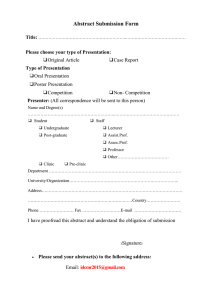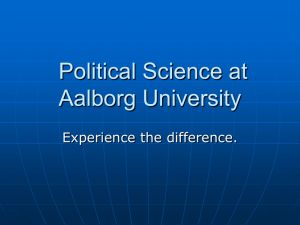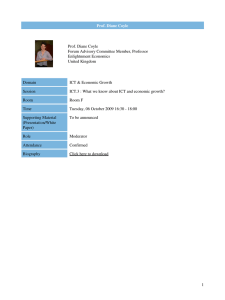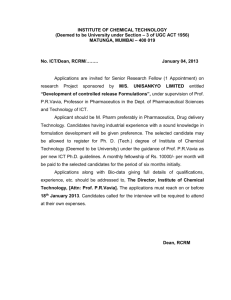http://it.civil.aau.dk/it/presentations/2006_11_delhi.ppt
advertisement
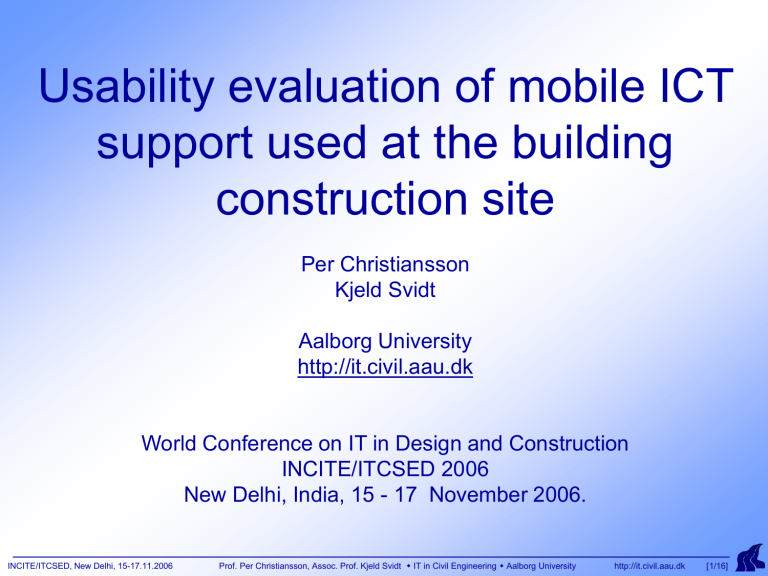
Usability evaluation of mobile ICT support used at the building construction site Per Christiansson Kjeld Svidt Aalborg University http://it.civil.aau.dk World Conference on IT in Design and Construction INCITE/ITCSED 2006 New Delhi, India, 15 - 17 November 2006. INCITE/ITCSED, New Delhi, 15-17.11.2006 Prof. Per Christiansson, Assoc. Prof. Kjeld Svidt IT in Civil Engineering Aalborg University http://it.civil.aau.dk [1/16] CONTENT • • • • • The ‘IT at Construction site’ project Today’s and tomorrows ICT support User needs and requirements capture Tests methodology and results Conclusions INCITE/ITCSED, New Delhi, 15-17.11.2006 Prof. Per Christiansson, Assoc. Prof. Kjeld Svidt IT in Civil Engineering Aalborg University http://it.civil.aau.dk [2/16] THE PROJECT The paper summarizes findings from field evaluations and controlled laboratory usability evaluations of new mobile Information and Communication Technology, ICT, support used by craftsmen at construction sites as well as a discussion of methodologies for user centred ICT tools design. The findings are derived from the Danish project 'IT at the Construction site' started in 2003 and ended in may 2005. (Follow-up project ongoing). The project was financed by the Danish Ministry of Science Technology and Innovation. (5+ SMEs participating). The project was started grounded lack of assembled activities to better utilise and develop Information and Communication Technology, ICT, tools at the building site.ICT domains covered in the project were - Construction web portal Digital document handling Mobile telephone technology for registration Education activities Collaboration between industry and research institutions Evaluation of construction site ICT tools Knowledge transfer INCITE/ITCSED, New Delhi, 15-17.11.2006 Prof. Per Christiansson, Assoc. Prof. Kjeld Svidt IT in Civil Engineering Aalborg University http://it.civil.aau.dk [3/16] ICT developments 1/2 VuMan 1991, CMU Digital Hardhat, UIUC, 1996 [wearLab] Bremen We are in an intense period of development where we can do creative design of future user environments. High quality models of building products and processes can be used in augmented reality environments to make collaboration and 4D simulations more effective, supported by underlying models and efficient data transfer. INCITE/ITCSED, New Delhi, 15-17.11.2006 Prof. Per Christiansson, Assoc. Prof. Kjeld Svidt IT in Civil Engineering Aalborg University http://it.civil.aau.dk [4/16] ICT developments 2/2 "Technology "auction" designed to rank the candidate technologies in term of near-term perceived values". From (Wood & Alvarez, 2005) page 10. INCITE/ITCSED, New Delhi, 15-17.11.2006 Prof. Per Christiansson, Assoc. Prof. Kjeld Svidt IT in Civil Engineering Aalborg University http://it.civil.aau.dk [5/16] Company information flow Focus support areas were administration and - Planning of man resources. - Time registration. - Registration of materials and equipment on projects (and cases/activities). - Integration with existing administrative systems at the companies The participating companies listed requirements on future systems that they meant should be paid attention to (grey arrows left). - Reduction of double registrations. - Secure digital registration of time- and resources spending. - Registration of purchases. - On-line access to detail planning system. - Utilization of data through many systems (systems interoperability). INCITE/ITCSED, New Delhi, 15-17.11.2006 Prof. Per Christiansson, Assoc. Prof. Kjeld Svidt IT in Civil Engineering Aalborg University http://it.civil.aau.dk [6/16] User Needs & Requirements Capture - Define user involvement (often heavily underestimated) with regard to user needs and requirements capture, functional user environment design including computer user interface, and continuous end user evaluations - The traditional system efficiency, effectiveness (do the system solve the targeted objectives), and user friendliness (how well do the system meet user expectations on the system) must be evaluated during system development and implementation. - We have used Contextual Design methodology for formal process description to strengthen development documentations and communication between project participants. (The same approach is used to develop a ICT support change process methodology in the continuation project 'ICT and Resource Management at the Building Site’) INCITE/ITCSED, New Delhi, 15-17.11.2006 Prof. Per Christiansson, Assoc. Prof. Kjeld Svidt IT in Civil Engineering Aalborg University http://it.civil.aau.dk [7/16] Laboratory Usability Tests 1/5 Users were observed by recording think-aloud, several video cameras and user activity logging in tested system and tests ended by a NASA-TLX test for registering of user stress during test (March 2004). The craftsmen (14, aged 18 - 36 years) were asked to solve 9 tasks, 40 minutes, (in short): 1. You are going to Mr Hansen to change a water stop cock in a ceramic tile. Set-up the task. 2. You have the following material and equipment in your car. The following equipment shall also be brought and therefore registered 3. You drive from the office to Mr. Hansen. Register driven km 4. After installation register the material used. 5. Another person from the company passes by and wants to borrow your flat chisel. Remove the equipment from the task. 6. You take a 10 minutes break. Register this in the system. 7. You discover that you only used 2 tiles and registered 3. Correct this information in the system. 8. You now get order from Master that you should continue on another task nr. yy, which is not completed. Start this task in the system. 9. Time to finish the day's work. Continue task tomorrow. Correct used time for today's first task (you actually started it 1 hour earlier). INCITE/ITCSED, New Delhi, 15-17.11.2006 Prof. Per Christiansson, Assoc. Prof. Kjeld Svidt IT in Civil Engineering Aalborg University http://it.civil.aau.dk [8/16] Laboratory Tests 2/5 The laboratory test facilities at Aalborg University. INCITE/ITCSED, New Delhi, 15-17.11.2006 Prof. Per Christiansson, Assoc. Prof. Kjeld Svidt IT in Civil Engineering Aalborg University http://it.civil.aau.dk [9/16] Laboratory Tests 3/5 Craftsmen to the left INCITE/ITCSED, New Delhi, 15-17.11.2006 Prof. Per Christiansson, Assoc. Prof. Kjeld Svidt IT in Civil Engineering Aalborg University http://it.civil.aau.dk [10/16] Laboratory Tests 4/5 Ericsson T68i Mobile phone equipped with barcode reader scanning a laminated barcode sheet. INCITE/ITCSED, New Delhi, 15-17.11.2006 Prof. Per Christiansson, Assoc. Prof. Kjeld Svidt IT in Civil Engineering Aalborg University http://it.civil.aau.dk [11/16] Laboratory Tests 5/5 Ericsson T68i Mobile phone mounted on video stand for capture of mobile phone keyboard and screen. The video camera is wirelessly connected to video recording device. INCITE/ITCSED, New Delhi, 15-17.11.2006 Prof. Per Christiansson, Assoc. Prof. Kjeld Svidt IT in Civil Engineering Aalborg University http://it.civil.aau.dk [12/16] Laboratory Usability Tests 6/6 Test Results - - - There is a great potential in barcode recording of especially components, material and driving activities The user interfaces must be further developed and take into account specific user interaction requirements Some basic heuristics were not fulfilled such as informative feedback on certain user actions, sometimes missing feed back on system status, not clear error codes, the user in charge of operations, and clear indications of status for different ongoing activities in the systems The end-users were in general rather satisfied with the performance of the tested systems and gave very positive feed-back from some users on the prospect of better control on resource use. The project has pointed out that the time needed for user needs and requirements capture was underestimated, as is very often the case. INCITE/ITCSED, New Delhi, 15-17.11.2006 Prof. Per Christiansson, Assoc. Prof. Kjeld Svidt IT in Civil Engineering Aalborg University http://it.civil.aau.dk [13/16] Main Conclusions 1/2 It is concluded from the project that small building construction firms' use of ICT tools in production still is limited. Some of the barriers recognized in the project are: - Limited understanding of possible achievements by using ICT tools. Limited overview of possibilities and barriers. Uncertainty regarding ICT implementation costs. Poor connection between existing ICT systems. Fear of being dependent on ICT tools. INCITE/ITCSED, New Delhi, 15-17.11.2006 Prof. Per Christiansson, Assoc. Prof. Kjeld Svidt IT in Civil Engineering Aalborg University http://it.civil.aau.dk [14/16] Main Conclusions 2/2 - The companies shall be prepared for the change in ICT tools support, and are keen to hear from other companies' experiences. - Anticipated effects shall be described and evaluated to increase insight into investment goals - Collaboration between companies, system deliverer and university is necessary for efficient development and implementation of systems.(Increased end user involvement) - Knowledge transfer routines should be improved. - System usability and interoperability must be improved including business ontology development. - Increased focus on education within IT in construction is needed. (The ongoing national Danish Digital Construction R&D program, DDB, will give important input to classification and use of building product and process models) INCITE/ITCSED, New Delhi, 15-17.11.2006 Prof. Per Christiansson, Assoc. Prof. Kjeld Svidt IT in Civil Engineering Aalborg University http://it.civil.aau.dk [15/16] END http://it.civil.aau.dk INCITE/ITCSED, New Delhi, 15-17.11.2006 Prof. Per Christiansson, Assoc. Prof. Kjeld Svidt IT in Civil Engineering Aalborg University http://it.civil.aau.dk [16/16]
